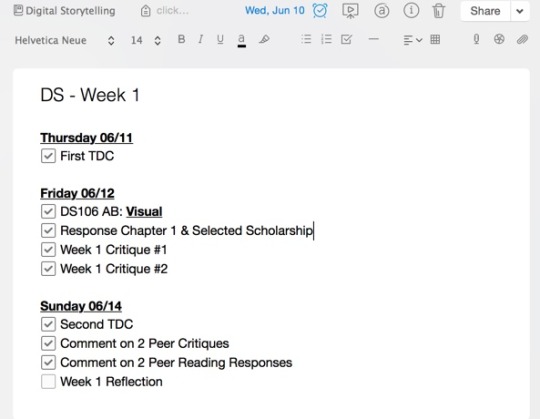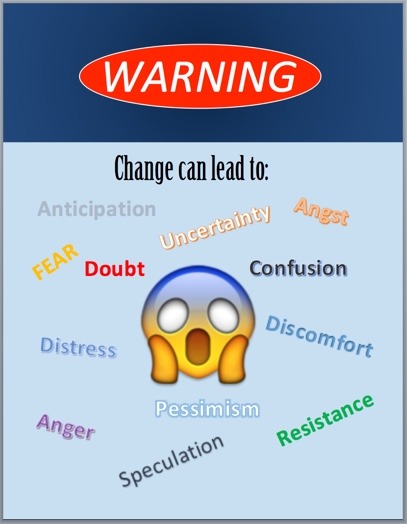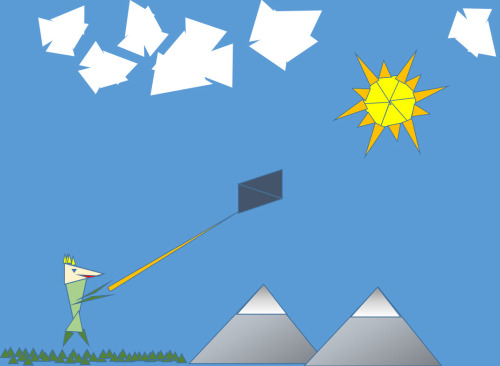-
Today’s Daily Create: Pick an opening line The ask for this assignment was to choose one of these 20 great opening line types and write my own great opening line. Well, I wouldn’t say mine was “great” by any stretch of the imagination, but here it is… “I am afraid I fear nothing.”

-
Digital Story Critique: Turning Fear into Fuel for Brilliance
The author, Jonathan Fields, opens his peach with some interesting and humorous dialogue on fear. He opens his speech with a question to the audience: What is the # 4 fear is within the world? Answer: DEATH. He then follows up with another question about the #1 fear – which is public speaking, which everyone in the audience shouts… More Digital Story Critique: Turning Fear into Fuel for Brilliance
-
INTE 5340 – Week 2 Reflection
How well did I complete the requirements of the weekly assignments? After last weeks roller coaster I think I’ve finally gained my bearings on how to proceed with the remaining 6 weeks of this course. With a hectic work and life schedule, I try to give as much effort to my assignments earlier in the… More INTE 5340 – Week 2 Reflection
-
Digital Story Critique: Participant/Observation
The author/anthropologist, Wynne Magggi, provides a well-told, somber story about her experience in Pakistan during PhD dissertation research. As an American women in a foreign land, Wynne faced a difficult decision surrounding the health and survival of a certain newborn baby boy. She was presented with a choice: flee the area with the baby in seek of… More Digital Story Critique: Participant/Observation
-
DS106AB – Sound of Your Day
For this assignment, I was tasked to record different sounds throughout my day and then combine them into a single audio file. Using nothing but audio to narrate my day forced me to pay close attention to my environment. This was fun and eye- (or ear-) opening for me. Our days are often too routine that… More DS106AB – Sound of Your Day
-
New Literacies – Chapter 2 Review
In chapter 2, Lankshear and Knobel take a deeper dive into the notion of “literacies”, specifically how “literacies are socially recognized ways in which people generate, communicate, and negotiate meanings, as members of Discourses, through the medium of encoded texts” (p. 45). I appreciated how the authors took their time to discuss the key points –… More New Literacies – Chapter 2 Review
-
Digital Story Critique: Cutting Through Confusion
The author, Aaron, provides a short narrative about his struggle with Schizophrenia and how his father’s support helped shape the man he is today. Note: My method of critique is derived from Jason Ohler’s Digital and Traditional Storytelling. The three traits I will focus on for this digital story will be 1) story, 2) research, and… More Digital Story Critique: Cutting Through Confusion
-
Daily Create – Favorite Moment
Today’s Daily Create: Draw the best moment of your life….. By no means am I an artist. In fact, I cringed at the thought of having to submit this assignment online. Nonetheless, the best moment of my life was when I became a father. The picture above is of my first born son, Jackson. He has… More Daily Create – Favorite Moment
-
Daily Create – Be a Kid Again
Today’s Daily Create: “write about what you would do if you could relive your childhood again”. I was a lazy child. Sure, during summer vacations I either camped with the family or rode my bike around the Cul-de-sac. But most of the time that I spent outside of school was dedicated to watching television. Show’s like He-Man and M.A.S.K. consumed half… More Daily Create – Be a Kid Again
-
Week 1 Reflective Summary
As week one slowly comes to a close I tell myself “only seven more weeks!”. Don’t get me wrong, I think this will be a great semester. Challenging, yes, but a definitely a learning opportunity.
If I were to use one word to summarize how I feel about this week: overwhelmed. After careful review of the course syllabus and Canvas pages, I identified at least 9 assignments due each week, not including the required reading. In an attempt to stay organized I created notes within Evernote to track when assignments were due each week, checking off those that have been completed (see image below). But please don’t think I’m simply completing assignments for the sake of completing them. If I felt that the workload was too much and could not provide quality assessments and critiques I would most likely drop this class.

I found most of the assignments fun and rewarding - especially the TDC’s and Visual AB. Although the critiques were not as fun, I am learning a lot from peer reviews as well as what I would/would not do for my own storytelling projects. I have used Twitter and Tumblr more in the past 5 days than I thought I ever word. Much thanks to Remi for providing other resources to track social media posts (Tweetdeck & Feedly).
It may be a little too early to have a favorite assignment. However the TDC assignments are engaging and fun. I get to see the creative side of my peers and leverage some of the ideas and design decisions for future projects.
At this point I can’t say I would do anything differently. I understand this is a summer class and naturally the pace and workload would be greater than if this were a traditional semester in length. I just didn’t imagine it would be like this.
As for my focal theme, I am struggling to find digital storytelling resources/samples to support my “change management”. Several assignments ask us to incorporate scholastic resources of our focal theme into our critique. This has been a challenge for me, prompting me to reconsider my theme.
Lastly, on a scale from 1-10 I think my participation in the class and completion of the assignments thus far is on par for a 10. The rubric clearly states that grads should not be awarded based on “effort”, but I hope there is at least an appreciation of all of the effort being made to complete these assignments in such a small amount of time - especially considering other obligations outside school (full-time work, family, etc).
-
Week 1 Reflective Summary
As week one slowly comes to a close I tell myself “only seven more weeks!”. Don’t get me wrong, I think this will be a great semester. Challenging, yes, but a definitely a learning opportunity. If I were to use one word to summarize how I feel about this week: overwhelmed. After careful review of the… More Week 1 Reflective Summary
-
New Literacies – Chapter 1 Review
Throughout the next 8 weeks I will spend an ample amount of time reviewing “New Literacies: Everyday Practices and Social Learning” by Colin Lankshear and Michele Knobel. The authors challenge readers to shift focus from the traditional definition of literacy, a difficulty reading and writing, to a notion of new literacy, acknowledging how social, economic, and cultural factors influence learning.
This week I am reviewing Chapter 1: From ‘reading’ to ‘new’ literacies. It is my aim in this post to identify and draw parallels to some of the terminology and concepts I interpret in the readings to my knowledge, experience, and understanding of the world as I see it.
Traditionally, when I hear or see the term literacy I immediately think of “illiteracy” – those who struggle with reading and writing. However, Lankshear and Knobel argue that literacy should be carefully examined by other factors – such as social, political, and economic influences. For example, the authors highlight how a nation’s economic growth may have direct correlation to the literacy level (Lankshear I Knobel, 2011, p. 8). As a learning specialist (corporate trainer), I have encountered many participants who have migrated from all over the U.S., as well as other nations. This is partially due to my home (San Diego) being a military hub for the Navy and Marie Corps, whose service men and women hail from various states or whose families are from overseas. Considering the adult learners I encounter in class may have varying educational and socioeconomic backgrounds, interpretations of words, phrases or technologies may be foreign to them.
Change Management, a focal theme of interest, serves as a key element in corporate America for the continuation and assimilation of new literacies, specifically media literacy, within organizations. According to the Center for Media Literacy (CML), “media literacy is a nexus for change because it links the outside world to gain competencies need for 21st century citizenship (Change Management, 2015). For the corporate staff that attend our training program, it is vital that they are able to develop critical thinking skills and use sound judgment when business policies/practices are ambiguous or are not “black and white”.
Another interesting fact that was mentioned is how some countries, either at a state or local setting, had (or may even continue to) offer incentives to companies and organizations that provide literacy competency programs and workshops for their staff (Lankshear I Knobel, 2011, p. 14). The idea here is to increase literacy so workers could be more proficient in what they do. This is core to what my mission as a corporate learning specialist is – ensure staff are proficient by providing training on systems, policies, procedures, and concepts that are specific to the organization. One could argue this as technical literacy.
This chapter mentioned several committees and reports – too much for me to call out here. However, there was one report that was published in 2007 by the US National Council of Teachers of English (NCTE) that caught my eye. Per this report, English Language Arts should:
…prepare students for an increasingly focus on ‘problem solving, collaboration, and analysis’, as well as on ‘skills with work processing, hypertext, LCDs, Web cams, digital software’…(Lankshear I Knobel, 2011, p. 24)
I’m not sure whether or not this is truly happening within the current U.S. education system (K-12). However, as an adult learning in an online graduate program, the expectation was set that I would need to become proficient in digital and online collaborative tools (i.e. Google Hangouts, WebEx, Zoom, etc.) For the adult learners who enter my training room, however, there seems to be a struggle with simple tasks such as typing and using basic computer software (i.e. Microsoft Office). Thankfully there are plenty of resources within my team to ensure staff are prepared for what is expected once they leave the training room.
Looking forward, I hope that future chapters will provide a little more insight into digital storytelling – a competency I currently lack proficiency in.
References:
Change Management. (n.d.). Retrieved June 12, 2015, from http://www.medialit.org/change-management
Lankshear, C. & Knobel, M. (2011). New Literacies: Everyday Practices and Social Learning. New York: Open University Press.
-
New Literacies – Chapter 1 Review
Throughout the next 8 weeks I will spend an ample amount of time reviewing “New Literacies: Everyday Practices and Social Learning” by Colin Lankshear and Michele Knobel. The authors challenge readers to shift focus from the traditional definition of literacy, a difficulty reading and writing, to a notion of new literacy, acknowledging how social, economic, and cultural factors influence learning.… More New Literacies – Chapter 1 Review
-
Digital Story Critique: Path to Technology
The video can be found at here. While searching for digital stories on change I came across a website called Stories of Change. The site has a catalog of many interesting stories, most of which are filtered based on categories of interest. In the span of 30 years, Dominguez Vazquez worked hard to make a… More Digital Story Critique: Path to Technology
-
Digital Story Critique: Path to Technology
The video can be found at here.
While searching for digital stories on change I came across a website called Stories of Change. The site has a catalog of many interesting stories, most of which are filtered based on categories of interest.
In the span of 30 years, Dominguez Vazquez worked hard to make a living. He spent 15 years as a shipbuilder, remodeling luxury cabins for cruise ships. He then spent an additional 15 years as a saucier at a hotel in San Francisco, serving food to the privileged. One day he had enough and needed a change.
His story takes us on a journey from leaving the shipyards and restaurant industry to learning web design and serving his community.
Note: My method of critique is derived from Jason Ohler’s Digital and Traditional Storytelling. The three traits I will focus on for this digital story will be 1) originality, voice, and creativity, 2) Media Application, and 3) Flow, Organization, and Pace. The reason I chose these three traits is partially due to the authors’ design decision for his story. This story was of a personal nature and the design decision made reflects the authors’ creative methodology.
Originality, Voice, and Creativity (10/10 pts)
The author did an exceptional job telling his story by providing a brief occupational history and leading up to his decision to make a change after 30 years. The story had many themes, but the two that stuck out the most were change and community - both were conveyed well in the presentation.
Media Application (8/10 pts)
The author used pictures to accompany his narrative. The photos were appropriate, however they were fuzzy and difficult to make out most of the time. The audio was also muffled at times too. If the author used a better microphone and perhaps a different recording area (i.e. quiet room, no florescent lighting, etc.) the quality of the audio may have been better. Likewise, the use of a higher-end screencast software may have resulted in a better looking final product. For these reasons I deducted 2 points from this category.
Flow, Organization, and Pace (10/10 pts)
The overall flow and pace was appropriate. It was directional and encompassed a beginning, middle, and end to the story. I really enjoyed reviewing this story because it was like watching a 2 minute movie of an individual who, after reflecting on his life, makes a change that benefits him and his community. He truly finds happiness with this change.
Total Score: 28 pts
-
Flower’s for MomToday’s Daily Create is to send flowers to…

Flower’s for Mom
Today’s Daily Create is to send flowers to someone a person of you choice.
These flowers are for my mother, who I have not seen in over 6 years. We live in separate states, roughly 560 miles apart. As a single parent of three (1 girl and 2-twin boys) my mother did what she could to get by. Sometimes that meant working 2-3 jobs at a time. To this day, at 62, my mom wakes up at 5:00 am to get to work nearly 40 miles away from where she resides.
We didn’t always get the most expensive toys or have extravagant vacations, but we always had each other. I miss her deeply and hope that some day she can see her grandchildren in person.
The photos above are of the same image, taken using my iPhone 6. I used an iOS application called ProCam 2 with the Kaleido II setting to get the image on the right. I then used another iOS application called Diptic to get the side-by-side profile.
-
Jason Dunbar 2015-06-12 11:57:19
Flower’s for Mom Today’s Daily Create is to send flowers to someone a person of you choice. These flowers are for my mother, who I have not seen in over 6 years. We live in separate states, roughly 560 miles apart. As a single parent of three (1 girl and 2-twin boys) my mother did what… More
-
Jason Dunbar 2015-06-11 23:43:46
Digital Story Critique: Lucid Shadows Jonathan Sciortino, a fellow veteran of the United States Marine Corps, provided a narrative of his experience and reflection of the Iraq War – Operation Enduring Freedom. The following is my critique of the authors’ narrative as a digital story. Note: My method of critique is derived from Jason Ohler’s Digital… More
-
Digital Story Critique: Lucid ShadowsJonathan Sciortino, a…
Digital Story Critique: Lucid Shadows
Jonathan Sciortino, a fellow veteran of the United States Marine Corps, provided a narrative of his experience and reflection of the Iraq War - Operation Enduring Freedom. The following is my critique of the authors’ narrative as a digital story.
Note: My method of critique is derived from Jason Ohler’s Digital and Traditional Storytelling.
Story (10/10 pts)
The authors’ use of dialog and vivid imagery evokes an emotional response, which was clear, well articulated and compelling. Listening to a story on the loss of a friend/solider and hearing a solider criticize the military as a “machine” may persuade the audience to think differently about their own perception of wartime events.
It can be difficult for audiences to relate to stories without having shared similar experiences as the storyteller. However, the author did an excellent job with his account of certain incidents, such as using sensory phrases as “smell of gasoline” and describing a fire as “dull orange” as it was engulfing a Humvee.
I feel that the story failed to in terms of story mapping. Essentially, the author provided a story with a problem but did not offer a solution. I appreciate the author’s perspective and offering such a significant story of his military career, but what alternative outcomes, if any, are presentable?
Flow, Organization, and Pacing (9/10 pts)
The story had a logical flow and was well organized with a beginning, middle, and end. There were several climactic elements within the story, emphasizing the authors’ main points. As noted before, drawing from emotional events makes a story more compelling and memorable for the audience.
The one drawback to this trait was the pace of the dialogue/narration. The pace at times seemed a little too slow. I assume the intent of the slow narration was to ensure that the audience can hear and understand every point made by the author.
Sense of Audience (10/10 pts)
Nobody loves war, but everyone loves a war story. This story meets the needs of most audience members - those who appreciate the sacrifices of our service men and women. Likewise, most audiences never will know what it’s like to be part of a hostile environment where the outgoing military unit telling you “it’s not a matter of if you get blown up, but when”. Well told stories like this one puts the audience as close to the war without any real risk.
The author did an excellent job telling his story. One element that is missing from this trait is a transcript or some type of text per slide. The visuals were powerful; however, for the hearing impaired they would not get the full story behind the narrative.
Total Score: 29/30
-
Random Act of Kindness
Today’s Daily Create assignment over at DS106 focuses on performing a random act of kindness and providing the story within the same day. On the way to work this morning I decided to do something that I don’t do – or like to to very often – which was eat McDonald’s. On the rare… More Random Act of Kindness
-
Warning of Change#visualassignments #visualassignments1549…

Warning of Change
#visualassignments #visualassignments1549 #ds106 #cudenver15
Everyone experiences change throughout their lifetime - new manager, birth of a child, loss of a pet, etc. I created this “warning” poster to illustrate some of the negative feelings and emotions we encounter during the initial phase of change. It’s important no to feel ashamed or embarrassed when we feel this way. These are all natural emotions to experience; however, we should work on finding constructive ways to channel these emotions, especially in the workplace, so we do not disrupt or damage the personal or professional relationships.
-
Jason Dunbar 2015-06-10 00:08:17
Warning of Change Everyone experiences change throughout their lifetime – new manager, birth of a child, loss of a pet, etc. I created this “warning” poster to illustrate some of the negative feelings and emotions we encounter during the initial phase of change. It’s important no to feel ashamed or embarrassed when we feel this… More
-
“Sun Day”The Daily Create Assignment – Shape PictureI have never…

“Sun Day”
The Daily Create Assignment - Shape Picture
I have never thought of myself as a creative/artistic individual. When I made a comment to one of my instructors that I didn’t have an artistic bone in my body, the instructor told me “if you have a soul, they you have creativity within you” (Thanks @johnpaulsharp).
As I perused through some of the Daily Create assignments submitted this week within DS106, I realized that people were having fun with their creations rather than simply completing an “assignment”. When I think of fun I think of the times I spend with my family - Disneyland, San Diego Zoo, parks, etc - and how their happiness brings me joy. This artwork is dedicated to them.
-
Jason Dunbar 2015-06-08 17:36:33
“Sun Day” The Daily Create Assignment – Shape Picture I have never thought of myself as a creative/artistic individual. When I made a comment to one of my instructors that I didn’t have an artistic bone in my body, the instructor told me “if you have a soul, they you have creativity within you” (Thanks… More
-
Don’t Mess with the Zoho
Zoho is a robust software company dedicated to helping companies and organizations solve complex problems with web-based solutions. The company also offers a full fledged, web-based Project Management program that enables Project Managers and Instructional Designers to plan, track and collaborate project tasks. What attracted me to this site was the simplicity and ease of… More Don’t Mess with the Zoho
-
Don’t Mess with the Zoho
Zoho is a robust software company dedicated to helping companies and organizations solve complex problems with web-based solutions.The company also offers a full fledged, web-based Project Management program that enables Project Managers and Instructi... -
Instructional Design and Development Blog
EdTech Magazine has named IDDblog as one of the 50 must-read instructional technologies blogs in higher education. Contributors of this blog include award-wining instructional designers and EdTech experts within the industry. The blog offers a perspective of teachers and students in relation to instructional design, eLearning, MOOC’s, web tools, and more. The blog is maintained… More Instructional Design and Development Blog
-
Instructional Design and Development Blog

EdTech Magazine has named IDDblog as one of the 50 must-read instructional technologies blogs in higher education. Contributors of this blog include award-wining instructional designers and EdTech experts within the industry. The blog offers a perspective of teachers and students in relation to instructional design, eLearning, MOOC’s, web tools, and more.
The blog is maintained by the Faculty Instructional Technology Services (FITS) department at DePaul University.
Some examples of good articles include:
What to expect when you’re expecting to teach online
-
Pecha Kucha…Gesundheit

A Pecha Kucha is a simple presentation format where you show 20 images, each for 20 seconds. The idea is that you strip down all of the fluff and filler normally within a PowerPoint presentation. Likewise, the images used within the presentation should be powerful enough to convey your message - hence the limited use of narration.
I was recently tasked to create a Pecha Kucha presentation for one of my graduate classes. I thought “hey, a PowerPoint presentation in 6 min, 40 seconds…no problem!”. However, once I started to outline my presentation I struggled to confine my content to only 20 seconds. It was extremely difficult to convey the messages I needed within such a confined amount of time. I must have recorded over 30 drafts of my presentation, running over the allotted time for each occurrence. I tried to revise sentences, cut out text, and speak slower, but some slides still when over.
Although the idea of keeping presentation short and direct, I am not sure the Pecha Kucha format is entirely necessary. Like any instructional/informative content, only time can measure whether your instruction made an impact on our audience, regardless of the delivery format.
-
Microsoft Word vs Adobe InDesign
When it comes to creating learning publication many people choose the tool that they, or their company, have at their disposal - which is either Microsoft Word or Pages for Mac.Both of these graphical work processing programs are just fine for creating...

